The sprint of a sprinter. The response of a goalkeeper. The decision of a tennis player is made in a fraction of a second. Is it all behind it? The cloud is terabytes. In addition to training more, athletes are training smarter. Without making a sound, cloud computing is changing how they train, prepare for games, and analyze them. The digital layer that previously played a supporting role is now at the centre of the stage in terms of measurement, comprehension, and enhancement of peak performance.
Real-Time Performance Tracking
Think of running a 40-yard dash and having your acceleration curve on the tablet of a coach before you stop your movement. That is the degree of urgency that the cloud introduces. Just like checking football odds to gauge the flow of a game, coaches now rely on live data to track performance shifts in real time. Shoes, vests, even bright socks have sensors that deliver live performance data into secure platforms, allowing coaches to adjust workouts in real-time.
There is no need to speculate whether an athlete is overworked or underperforming, because the figures speak for themselves. Biometrics, such as lactate thresholds and HRV, are monitored and measured in real-time through cloud-based dashboards. Trainers do not wait until a report on the injury has been received; they observe fatigue patterns in motion. Cloud computing is not only keeping pace with the athlete, but it is also ahead of the athlete, indicating where the athlete will be a second before they arrive.

Remote Coaching and Collaboration
Training is no longer over when the athlete goes out of the facility. The cloud enables knowledge to be accessible everywhere and at any time. Athletes are keeping in sync across continents, languages, and time zones.
This is the way the best are using it:
- Live video analysis: Coaches can live-stream drills and analyze them with frame-by-frame accuracy.
- Standard data vaults: All nutritionists, doctors, and trainers use the same health and training logs.
- Virtual tactical boards: Coaches plan on the spot, changing formations or matchups thousands of miles away.
It is no longer a matter of people who are physically present in the room, but a matter of people who are connected to the cloud.
Enhancing Decision-Making Through Data
It is no longer a matter of guesswork, but rather a matter of precision based on data. Cloud platforms not only store information, but they also hone instincts. Whether it is the readiness of the players or the pattern of the opponents, cloud-powered insights make coaches and athletes tacticians: faster, smarter, and more challenging to outsmart.
Predictive Analytics in Training
Fatigue is sometimes not reflected in the scoreboard, but the cloud picks it up before it loses a game. Predictive models can accurately predict the decline well before injuries become apparent by monitoring micro-movements, the rate of recovery, and sleep patterns. It is not magic. It is mathematics and movement.
Athletes no longer need to work through the pain, but instead, they need to work more intelligently. In the case of cloud-fed data, performance staff can dynamically vary the load without burning out, to maximize peak windows. Each rep has a rationale, based on probability, rather than tradition. Blind grind is no more.
Game Strategy Optimization
A coach would depend on the gut feeling and the highlight reel. They now conduct film reviews using heat maps and probability charts. Thousands of plays, by player, by team, by formation, are stored and compared in cloud systems to bring to light what is not otherwise seen.
That advantage counts: noticing the hesitation of a defender, when an opponent always blitzes, and which side of the goalie is weak. Teams can play against situations using real information about the opponent, rather than outdated assumptions. Strategy is no longer a game of chance; it is a computation.

Scalable Recovery Programs
An injury is not merely a setback; it is a defining point. The cloud-based recovery tools monitor muscle response, inflammation patterns, and healing rates in real-time. Rehabilitation has ceased to be a fixed prescription. It is a dynamic system that changes every hour, with the body of the athlete. All updates, changes, and milestones are recorded, communicated, and examined in real-time.
The clipboard notes and live inputs, including movement sensors, digital strain tests, and feedback from a remote therapist, now power intuition that once existed. A ruptured hamstring or swelling caused by surgery, whichever the case may be, recovery is quicker and more personalized than ever before. Cloud computing enables physical therapy to be measurable, customized, and, above all, optimized.
The New Standard in Sports Excellence
Raw talent is no longer enough. The best athletes are combining instincts with insights, and the distinction is where it counts most: performance. Cloud computing is not a tool; it is the backbone of excellence these days.

Leave a Reply